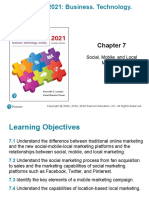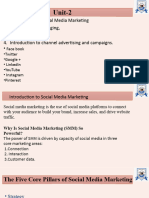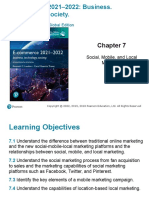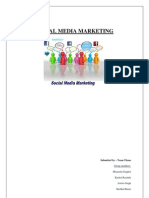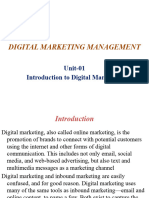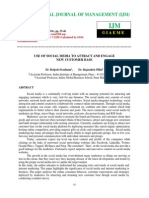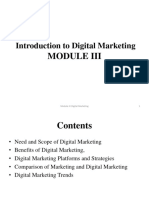0 ratings0% found this document useful (0 votes)
3 viewsMKTG12 LambHairMcDaniel Ch18 Updated SH
MKTG12 LambHairMcDaniel Ch18 Updated SH
Uploaded by
Ada EspinolaCopyright:
© All Rights Reserved
Available Formats
Download as PPTX, PDF, TXT or read online from Scribd
MKTG12 LambHairMcDaniel Ch18 Updated SH
MKTG12 LambHairMcDaniel Ch18 Updated SH
Uploaded by
Ada Espinola0 ratings0% found this document useful (0 votes)
3 views26 pagesOriginal Title
MKTG12 LambHairMcDaniel Ch18 Updated SH (1)
Copyright
© © All Rights Reserved
Available Formats
PPTX, PDF, TXT or read online from Scribd
Share this document
Did you find this document useful?
Is this content inappropriate?
Copyright:
© All Rights Reserved
Available Formats
Download as PPTX, PDF, TXT or read online from Scribd
Download as pptx, pdf, or txt
0 ratings0% found this document useful (0 votes)
3 views26 pagesMKTG12 LambHairMcDaniel Ch18 Updated SH
MKTG12 LambHairMcDaniel Ch18 Updated SH
Uploaded by
Ada EspinolaCopyright:
© All Rights Reserved
Available Formats
Download as PPTX, PDF, TXT or read online from Scribd
Download as pptx, pdf, or txt
You are on page 1of 26
MKTG
Principles Of Marketing
Twelfth Edition
Chapter 18
Social Media
Marketing
© 2019 Cengage. All rights reserved.
Learning Outcomes
18-1 Describe social media, how they are used, and
their relations to integrated marketing communications
18-2 Explain how to create a social media campaign
18-3 Evaluate the various methods of measurement
for social media
18-4 Explain consumer behavior on social media
18-5 Describe the social media tools in a marketer’s
toolbox and how they are useful
18-6 Describe the impact of mobile technology on social
media
18-7 Understand the aspects of developing a social
media plan
© 2019 Cengage. All rights reserved.
What Are Social Media?
(slide 1 of 3)
• Social media: Any tool or service that uses the
Internet to facilitate conversations
• It can also be defined relative to traditional
advertising like television and magazines, but social
media offer a more one-to-one interaction with
customers
© 2019 Cengage. All rights reserved.
What Are Social Media?
(slide 2 of 3)
• Social media have several implications for marketers and
the ways that they interact with their customers:
– Marketers must realize that they often do not control the
content on social media sites
– The ability to share experiences quickly and with such large
numbers of people amplifies the impact of word of mouth in
a way that can affect a company’s bottom line
– Social media allow marketers to listen
– Social media provide more sophisticated methods of
measuring how marketers meet and interact with consumers
than traditional advertising does
– Social media allow marketers to have much more direct and
meaningful conversations with customers
© 2019 Cengage. All rights reserved.
What Are Social Media?
(slide 3 of 3)
• Social media have changed how and where
conversations take place, globalizing human
interaction
• Companies are also beginning to understand the
implications of their employees’ activities on social
media
© 2019 Cengage. All rights reserved.
How Consumers Use Social Media
• It is important for marketers to understand which social
media consumers are using and how they are using them
– Young adult singles use Match.com, OkCupid, and Tinder
– Teens use Snapchat, Instagram, Twitch, and Tumblr
– Older teens and adults use Facebook
• Increased use of smartphones and tablet computers has
contributed to the spread of social media usage
© 2019 Cengage. All rights reserved.
Social Commerce
(slide 1 of 2)
• Social commerce: a subset of e-commerce that
involves the interaction and user contribution aspects
of social online media to assist online buying and
selling of products and services
• Social commerce sites
– Include ratings and recommendations
– Help consumers make more informed decisions on
purchases and services
© 2019 Cengage. All rights reserved.
Social Commerce
(slide 2 of 2)
• Types of social commerce
– Peer-to-peer sales platforms
– Social networking websites driven by sales
– Group buying platforms
– Peer recommendation sites
– User-curated shopping sites
– Participatory commerce platforms
– Social shopping sites
– Shoppable videos
© 2019 Cengage. All rights reserved.
Social Media and Integrated
Marketing Communications
• Marketers can use social media to have
conversations with consumers, forge deeper
relationships, and build brand loyalty
• Consumers connect with each other, share opinions,
and collaborate on new ideas according to interests
• Crowdsourcing: using consumers to develop and
market products
© 2019 Cengage. All rights reserved.
Creating and Leveraging a
Social Media Campaign
• Companies should start with a strategy before diving
head first into social media
– Start with a marketing or communications plan
– Situation analysis, objectives, and evaluation are still
essential
• Marketers can categorize media types into owned,
earned, and paid media
• To leverage all three types, markets must:
– Maximize owned media
– Public relations do not translate to earned media
– Paid media must drive customer engagement
© 2019 Cengage. All rights reserved.
The Listening System
• Developing an effective listening system is necessary
in understanding and engaging an online audience
• Social media monitoring: the process of identifying
and assessing what is being said about a company,
individual, product, or brand
• Failure to respond to criticism leads to a larger crisis
© 2019 Cengage. All rights reserved.
Social Media Objectives
• The organization should develop a list of objectives
for its social media team to accomplish
• Considerations when setting objectives:
– Listen and learn
– Build relationships and awareness
– Promote products and services
– Manage your reputation
– Improve customer service
© 2019 Cengage. All rights reserved.
Evaluation and Measurement
of Social Media
• Social media have the potential to revolutionize the
way organizations communicate with stakeholders
• Five steps to help gauge the effectiveness of a social
media effort:
– Identify your key performance indicators (KPIs)
– Align your social media goals with your business
objectives
– Set up Google Analytics to track conversions
– Assign values to your KPIs (such as lifetime value or
average sales)
– Benchmark against your competitors
© 2019 Cengage. All rights reserved.
Social Media Metrics
• Buzz
• Interest
• Participation and engagement
• Search engine ranks and results
• Influence
• Sentiment analysis
• Website metrics
© 2019 Cengage. All rights reserved.
Social Behaviors of Consumers
• Understanding an audience necessitates
understanding how that audience uses social media
• Six categories of social media users:
– Creators
– Critics
– Collectors
– Joiners
– Spectators
– Inactives
– Conversationalists
© 2019 Cengage. All rights reserved.
Discussion Point
Categories of Social Media Users
• Have students identify which category or social
media users they fall into.
• What types of companies or products are students
interacting with online?
• Does their categorization impact these interactions?
© 2019 Cengage. All rights reserved.
Social Media Tools: Consumer- and
Corporate-Generated Content (slide 1 of 4)
• Blog: a publicly accessible web page that functions
as an interactive journal, whereby readers can post
comments on the author’s entries
– Corporate blogs: blogs that are sponsored by a company
or one of its brands and maintained by one or more of the
company’s employees
– Noncorporate blogs: independent blogs that are not
associated with the marketing efforts of any particular
company or brand
• Microblog: blogs with strict post length limits
© 2019 Cengage. All rights reserved.
Social Media Tools: Consumer- and
Corporate-Generated Content (slide 2 of 4)
• Social networking sites: websites that allow
individuals to connect—or network–with friends,
peers, and business associates
– A company may create a brand-specific social network
or community
– Facebook can help a brand increase its social media
presence and optimize search engine results
– LinkedIn is used primarily by professionals who wish to
build their personal brands online and businesses that
are recruiting employees and freelancers
© 2019 Cengage. All rights reserved.
Social Media Tools: Consumer- and
Corporate-Generated Content (slide 3 of 4)
• Media sharing sites: websites that allow users to
upload and distribute multimedia content like videos
and photos
• Social news sites: websites that allow users to
decide which content is promoted on a given website
by voting that content up or down
• Location-based social networking sites: websites
that combine the fun of social networking with the
utility of location-based GPS technology
© 2019 Cengage. All rights reserved.
Social Media Tools: Consumer- and
Corporate-Generated Content (slide 4 of 4)
• Review sites: websites that allow consumers to post,
read, rate, and comment on opinions regarding all
kinds of products and services
• Virtual worlds and online gaming
– Massive multiplayer online (MMO) games
– Competitive online games
– Online communities (or virtual worlds)
© 2019 Cengage. All rights reserved.
Discussion Point
Social Media Tools
• Have students identify which social media tools they
use and how often they use them.
• What companies or products do you recall seeing
advertised?
• Were the advertisements effective? Why or why not?
© 2019 Cengage. All rights reserved.
Social Media and Mobile Technology
(slide 1 of 2)
• Reasons for recent popularity of mobile marketing
– Low barrier to entry
– Consumers acclimating to privacy and pricing policies
– Effective at garnering consumer attention in real time
– Measurable
– In-store notification technology
– Higher response rate than traditional media types
© 2019 Cengage. All rights reserved.
Social Media and Mobile Technology
(slide 2 of 2)
• Common mobile marketing tools:
– SMS (short message service)
– MMS (multimedia messaging service)
– Mobile website (MOBI and WAP website)
– Mobile ads
– Bluetooth marketing
– Smartphone applications (apps)
• Apps and widgets
© 2019 Cengage. All rights reserved.
The Social Media Plan
• The social media plan is linked to promotional plans
or marketing plans
• Six stages involved in creating an effective social
media plan:
– Listen to customers
– Set social media objectives
– Define strategies
– Identify the target audience
– Select the tools and platforms
– Implement and monitor the strategy
© 2019 Cengage. All rights reserved.
The Changing World of Social Media
• The rate of change in social media is astounding—
usage statistics change daily for sites like Facebook
and Twitter
© 2019 Cengage. All rights reserved.
Key Terms
• Social media
• Social commerce
• Crowdsourcing
• Social media monitoring
• Blog
• Corporate blogs
• Noncorporate blogs
• Microblogs
• Social networking sites
• Media sharing sites
• Social news sites
• Location-based social networking sites
• Review sites
© 2019 Cengage. All rights reserved.
You might also like
- Chapter 7. Social Mobile and Local MarketingDocument44 pagesChapter 7. Social Mobile and Local MarketingThiên Hương100% (1)
- Sixteenth Edition: Social, Mobile, and Local MarketingDocument47 pagesSixteenth Edition: Social, Mobile, and Local MarketingPhúc LợiNo ratings yet
- Chapter 5 - Social Media Living in The Connected World PDFDocument26 pagesChapter 5 - Social Media Living in The Connected World PDFHariz SyahmiNo ratings yet
- Unit 2 - Digital MarketingDocument39 pagesUnit 2 - Digital MarketingRahul KumarNo ratings yet
- MM Module 4Document35 pagesMM Module 4wordsawwNo ratings yet
- Advertising 2Document35 pagesAdvertising 2Sông HươngNo ratings yet
- Laudon Traver Ec16 PPT Ch07 Accessible 26022023 080500pmDocument46 pagesLaudon Traver Ec16 PPT Ch07 Accessible 26022023 080500pmGreson JamesNo ratings yet
- Social Media MarketingDocument24 pagesSocial Media MarketingKristine Grace100% (1)
- Lecture 05 - Social MediaDocument30 pagesLecture 05 - Social MediaharshidbvNo ratings yet
- Digital MarketingDocument29 pagesDigital MarketingRishabh Gangwar67% (3)
- CHAPTER 8 - Implementing Strategies Marketing, Finance and Accounting, Research and Development, and MIS IssueDocument17 pagesCHAPTER 8 - Implementing Strategies Marketing, Finance and Accounting, Research and Development, and MIS IssueShelly Mae SiguaNo ratings yet
- Digital Marketing and Social Media MarketingDocument59 pagesDigital Marketing and Social Media MarketingKeibeeNo ratings yet
- Final ReportDocument9 pagesFinal ReportZarish AshrafNo ratings yet
- Ch 4 Social Media MarketingDocument20 pagesCh 4 Social Media Marketingdiyasebastin24No ratings yet
- Research Methodology - Digi MarketingDocument23 pagesResearch Methodology - Digi Marketingranson dantis67% (6)
- Scrib 3Document4 pagesScrib 3vaibhavagarwal1234lmpNo ratings yet
- Span Image How To Make Your Online Ads Work For YouDocument23 pagesSpan Image How To Make Your Online Ads Work For YouICT AUTHORITYNo ratings yet
- We Are All Connected: The Power of Social Media Ecosystem Case Analysis - PresentationDocument26 pagesWe Are All Connected: The Power of Social Media Ecosystem Case Analysis - PresentationAkash RajputNo ratings yet
- 1-Social Media & E-CommerceDocument27 pages1-Social Media & E-CommerceEl mundo de Daniela MNo ratings yet
- Pemasaran DigitalDocument17 pagesPemasaran DigitalR KNo ratings yet
- BBA Marketing Management II Session 3Document79 pagesBBA Marketing Management II Session 3Ravikant Reddy VadamalaNo ratings yet
- Social Media MarketinDocument19 pagesSocial Media MarketinHimanshi SinghalNo ratings yet
- Social Networking WebsitesDocument5 pagesSocial Networking WebsitesYash ThakkarNo ratings yet
- DSMM Unit 1Document50 pagesDSMM Unit 1hussain21200612No ratings yet
- SBL-3 DM MIdtermPrepManualDocument5 pagesSBL-3 DM MIdtermPrepManualbloodhornoffNo ratings yet
- The Complete Guide To Social Media Marketing Thebi - 220706 - 085607Document63 pagesThe Complete Guide To Social Media Marketing Thebi - 220706 - 085607Tawanda Victor MashavaNo ratings yet
- Keller SBM5e Accessible CH07Document30 pagesKeller SBM5e Accessible CH07linhndhs173025No ratings yet
- The Impact of Social Media Marketing OnDocument14 pagesThe Impact of Social Media Marketing OnPRATIK KEJRIWALNo ratings yet
- SC Tutorial 4Document9 pagesSC Tutorial 4Stephanie WongNo ratings yet
- CH6 Week 6Document17 pagesCH6 Week 6nrdeen.khNo ratings yet
- Digital_marketing (HK)Document21 pagesDigital_marketing (HK)HRITHIK KambleNo ratings yet
- Chapter 21 Digital Marketing Online Marketing Social Media Mobile 09012024 011856pm 21052024 095218amDocument24 pagesChapter 21 Digital Marketing Online Marketing Social Media Mobile 09012024 011856pm 21052024 095218amzara mughalNo ratings yet
- POEM Social Listening LARADocument53 pagesPOEM Social Listening LARASaurabh MittalNo ratings yet
- ISB - DMA - W4 - Video TranscriptsDocument16 pagesISB - DMA - W4 - Video Transcriptsvijju006No ratings yet
- DIGITAL MARKETING final hkDocument21 pagesDIGITAL MARKETING final hkHRITHIK KambleNo ratings yet
- Chapter 7 SPR 2020Document44 pagesChapter 7 SPR 2020Nhan Doan Ngoc ThanhNo ratings yet
- Sharath Digital MarketingDocument31 pagesSharath Digital Marketingsharath.acumbaNo ratings yet
- Session 01Document5 pagesSession 01Anudyouti SamantarayNo ratings yet
- Social Media MarketingDocument3 pagesSocial Media MarketingMBAZIIRA HATIMNo ratings yet
- JjRjjacZoSnEV6XG 663Document236 pagesJjRjjacZoSnEV6XG 663Abdoul karimNo ratings yet
- Social Media Networks Mas 203Document66 pagesSocial Media Networks Mas 203harunasofiu10100% (1)
- 6.P2. Marketing Using Digital Communication ChannelsDocument23 pages6.P2. Marketing Using Digital Communication ChannelsHoa Ngọc HânNo ratings yet
- Chapter07 - Branding in The Digital EraDocument31 pagesChapter07 - Branding in The Digital EraThảo PhươngNo ratings yet
- Unit-6Document16 pagesUnit-6Om MallikNo ratings yet
- DM ch.2Document57 pagesDM ch.2Tala MomaniNo ratings yet
- CH 6 RelationDocument25 pagesCH 6 RelationSARA َNo ratings yet
- Surabhi Agarwal - AbstractDocument8 pagesSurabhi Agarwal - AbstractSurabhi AgarwalNo ratings yet
- Social Media and Its Impact in Marketing Strategy PDFDocument7 pagesSocial Media and Its Impact in Marketing Strategy PDFrankiadNo ratings yet
- Scrib 4Document7 pagesScrib 4vaibhavagarwal1234lmpNo ratings yet
- ModifiedDocument64 pagesModifiedAmrutha VNo ratings yet
- Use of Social Media To Attract and Engage New Customer BaseDocument12 pagesUse of Social Media To Attract and Engage New Customer BaseIAEME PublicationNo ratings yet
- Digital Marketing (7. Social Media Marketing)Document102 pagesDigital Marketing (7. Social Media Marketing)nanekaraditya06100% (1)
- E-Commerce 2019: Business. Technology. Society.: Fifteenth EditionDocument51 pagesE-Commerce 2019: Business. Technology. Society.: Fifteenth EditionAhmed Deq MuseNo ratings yet
- Chapter06 - Integrating Marketing Communications To Build Brand EquityDocument27 pagesChapter06 - Integrating Marketing Communications To Build Brand EquityThảo PhươngNo ratings yet
- Social Media Marketing EngDocument18 pagesSocial Media Marketing Engfarzan ahmadNo ratings yet
- Social MediaDocument3 pagesSocial MediaKatherine Dela CruzNo ratings yet
- Laudon Traver Ec16 PPT Ch07 Accessible 04102022 025213pmDocument30 pagesLaudon Traver Ec16 PPT Ch07 Accessible 04102022 025213pmnimra nazimNo ratings yet
- Digital Marketing Module IIIDocument45 pagesDigital Marketing Module IIIShakti SinghNo ratings yet
- Untitled DocumentDocument60 pagesUntitled Documentanusafathima8No ratings yet
- ALS ProjectDocument28 pagesALS Projectpk587572No ratings yet
- MARK302 2023 Test Cindy Barbie Doll Ngwenya 22Document8 pagesMARK302 2023 Test Cindy Barbie Doll Ngwenya 22Cindy NgwenyaNo ratings yet
- Assignment 2Document4 pagesAssignment 2shreya.kapoor1074No ratings yet
- Wild Cookbook's YouTube Stats (Summary Profile) - Social Blade StatsDocument1 pageWild Cookbook's YouTube Stats (Summary Profile) - Social Blade StatskumaranayakemadurangaNo ratings yet
- AVĐB1 - Unit 1 - Post WritingDocument2 pagesAVĐB1 - Unit 1 - Post WritingThái Thanh ThanhNo ratings yet
- How To Write A BlogDocument2 pagesHow To Write A BlogSpaceKJK100% (1)
- Privacy and Security in Online Social Media - Unit 13 - Research Papers Part - IIDocument6 pagesPrivacy and Security in Online Social Media - Unit 13 - Research Papers Part - IIanseynoodlesNo ratings yet
- Digital Divide Slide 3Document11 pagesDigital Divide Slide 3arnielneminNo ratings yet
- Checklist For Finding The Right InfluencersDocument2 pagesChecklist For Finding The Right InfluencersAna Carolina PortelaNo ratings yet
- Radiomuseum Funkwerk Zittau HMK sd200 1500195Document2 pagesRadiomuseum Funkwerk Zittau HMK sd200 1500195mirNo ratings yet
- WEB 1,2 and 3Document3 pagesWEB 1,2 and 3Atta Ur RahmanNo ratings yet
- AirportsDocument11 pagesAirportsHùng PhanNo ratings yet
- E Tech Web1.0 Web3.0Document36 pagesE Tech Web1.0 Web3.0Myka Shanelle MabaelNo ratings yet
- Final Requirement in TrendsDocument2 pagesFinal Requirement in Trendspatrick.paraguyaNo ratings yet
- Psy 037 Social Psychology p2Document6 pagesPsy 037 Social Psychology p2kian ram medinaNo ratings yet
- Media Information Literacy q1 Module 1Document10 pagesMedia Information Literacy q1 Module 1jethii acabalNo ratings yet
- Background of The Study Statement of The ProblemDocument3 pagesBackground of The Study Statement of The ProblemKen ArellanoNo ratings yet
- 2 ConformityDocument31 pages2 Conformitystoneage989No ratings yet
- Meme Marketing TrendsDocument8 pagesMeme Marketing TrendsJESSA MARIE BALONGCAS (BALONGCAS JESSA MARIE D.)No ratings yet
- SocialMedia Strategy Worksheet - v2Document11 pagesSocialMedia Strategy Worksheet - v2heheomo11No ratings yet
- Graphic Designer ResumeDocument2 pagesGraphic Designer Resumemanish.canvaloginNo ratings yet
- Opinion Column TaskDocument3 pagesOpinion Column TaskJuan de Dios Vicuña RNo ratings yet
- Ethics, Integrity & Aptitude Gs 4Document131 pagesEthics, Integrity & Aptitude Gs 4vinamraNo ratings yet
- Levy 11e PPT Ch03 ACCESSDocument7 pagesLevy 11e PPT Ch03 ACCESSthanhnganzuizeNo ratings yet
- Title:: The Institutionalisation of Social Media in Politics: Dynamics, Applications, Critiques, and ChallengesDocument2 pagesTitle:: The Institutionalisation of Social Media in Politics: Dynamics, Applications, Critiques, and Challengestommysamudra4No ratings yet
- Influencer Content ManipulationDocument17 pagesInfluencer Content Manipulationp54rjnsjktNo ratings yet
- InternetDocument2 pagesInternetAymane FireNo ratings yet
- Comparative Contrast Essay (Facebook vs Instagram)Document2 pagesComparative Contrast Essay (Facebook vs Instagram)wiam harryNo ratings yet
- MACJ and MAEMADocument5 pagesMACJ and MAEMAshaileshNo ratings yet
- 2. Gaurav KumarDocument2 pages2. Gaurav KumarabhishekdubeyinNo ratings yet

